By Tom Thornsen
Victory Games – The Civil War
In 1983, Victory Games published The Civil War, one of the classic games to cover the entire American Civil War. A small group of people have continued to play this game and improve upon it over the following years. After several years of playing For the People, the GMT Games title that is based on this classic, I have decided to return to this game and see if I can relive those times 25 years ago when I had so much fun playing this game. The first thing I will have to do is ‘unlearn’ some the strategies and tactics of For the People, since there are significant differences in how the games play.
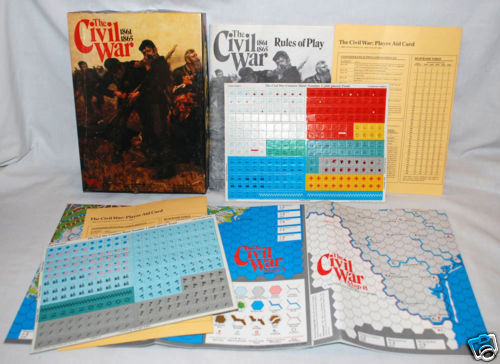 The area of operations for the standard game of The Civil War is divided into three (3) theaters. The East includes the states between the Atlantic coast and the Allegheny mountains to include the Carolinas, the West encompasses the states between the mountains and the Mississippi river to include Georgia and Florida and the Trans-Mississippi theater consists of the states West of the Mississippi river. There is an optional 2nd map that extends westward all the way to New Mexico. I will not discussing that. Each turn the players will designate one of these three theaters as primary, one as secondary and one as tertiary. Command Points are assigned to each theater based on these established priorities. There are also a small number of “Discretionary” CPs that may be spent in any theater and the USA (only) receives Naval CPs for activating naval units and leaders. Both players will use these command points to move units and leaders, construct fortifications, conduct naval operations and all the other military operations the war required.
The area of operations for the standard game of The Civil War is divided into three (3) theaters. The East includes the states between the Atlantic coast and the Allegheny mountains to include the Carolinas, the West encompasses the states between the mountains and the Mississippi river to include Georgia and Florida and the Trans-Mississippi theater consists of the states West of the Mississippi river. There is an optional 2nd map that extends westward all the way to New Mexico. I will not discussing that. Each turn the players will designate one of these three theaters as primary, one as secondary and one as tertiary. Command Points are assigned to each theater based on these established priorities. There are also a small number of “Discretionary” CPs that may be spent in any theater and the USA (only) receives Naval CPs for activating naval units and leaders. Both players will use these command points to move units and leaders, construct fortifications, conduct naval operations and all the other military operations the war required.
The standard game runs 19 turns, with each turn representing 2 months with a winter turn 4 months. Five (5) turns for a year. Each side has a fixed reinforcement schedule that supplies Strength Points (SPs) at an historical rate. The USA will start with 37 SPs on the board and receive 159 SPs as reinforcements during the course of the game. The CSA will start with 25 SPs and receive 132 SPs as reinforcements. This 39 SP advantage to the USA (~25% more) is significant, but with the burden of attack on the USA they will need to employ them wisely.
Both sides strive to accumulate Victory Points through military operations. Most of the USA Victory Points will come from the occupation of cities in neutral and Confederate states. Bonus Victory Points are awarded once all the VP cities in a state are in the possession of the USA at the end of a turn. The Confederate side can secure some early Victory Points by controlling cities in the neutral states, but the superior resources of the USA will eventually convert the neutral states to the USA cause. The Confederate player also gains VPs each time the Command Point Table is used to grant both sides command points and for raiding USA merchant shipping. There are significant Victory Points awarded for the CSA capture of Washington DC which could lead to an early CSA victory, but this will rarely occur with reasonable USA play. Defending the capital is the highest priority for the USA player the first few turns.
There are scenario ending and starting positions for each year of the war. Turns 1-3 are 1861, 4-8 are 1862, 9-13 are 1863, 14-17 are 1864 up to the election. Should the USA have sufficient VPs at the election to continue the war it will go two more turns (19 turns total) where final victory is determined in April of 1865.
Overall Strategy for each side.
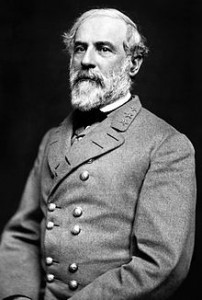 The top priority for the USA in the early game is to defend Washington DC. Read rule 4.1.6 for the dire consequences of CSA control of your capitol. The CSA could attempt this in the early turns, but this would consume a great deal of CSA resources early and is reasonably easy for the USA player to counter. With that primary objective secure, the USA strategy is driven by the need to occupy all the VP cities in a state. Neutral states will convert to USA friendly states and original confederate states will convert to neutral states. This is done by a combination of sending armies south to convert the railroads and capture cities, using the rail network to provide supply and using ocean transports and ironclads to capture coastal cities. The ground war in the west is facilitated by the USA riverine forces that can transport USA SPs deep into confederate territory and block confederate supply and force movement across the rivers. As was historically true, the USA naval power starts weak, but by 1862 (turn 4) grows strong enough for significant combined land/naval operations.
The top priority for the USA in the early game is to defend Washington DC. Read rule 4.1.6 for the dire consequences of CSA control of your capitol. The CSA could attempt this in the early turns, but this would consume a great deal of CSA resources early and is reasonably easy for the USA player to counter. With that primary objective secure, the USA strategy is driven by the need to occupy all the VP cities in a state. Neutral states will convert to USA friendly states and original confederate states will convert to neutral states. This is done by a combination of sending armies south to convert the railroads and capture cities, using the rail network to provide supply and using ocean transports and ironclads to capture coastal cities. The ground war in the west is facilitated by the USA riverine forces that can transport USA SPs deep into confederate territory and block confederate supply and force movement across the rivers. As was historically true, the USA naval power starts weak, but by 1862 (turn 4) grows strong enough for significant combined land/naval operations.
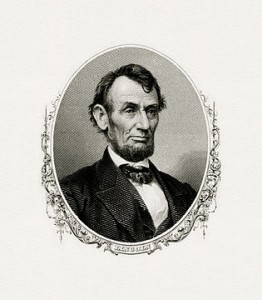 As the game opens the Confederate player is in a position to contest Missouri and, perhaps, West Virginia. The USA starts in control of all the VP cities in West Virginia except Grafton, which usually goes to the side that wins the first initiative roll. The supply situation in both states is tenuous for the CSA, so he will need to carefully consider how long he wants to contest those areas. During the first couple of years of the war the USA enjoys a very slight advantage in terms of reinforcements and Command Point usage. As the game progresses into 1864 (turn 14) the Confederate cause begins to run out of reinforcements and the Blockade reduces imports by 30%. If the USA has taken more than just a few ports, this loss of supply points will lead to increase costs in Command Points for many actions, eventually paralyzing CSA forces.
As the game opens the Confederate player is in a position to contest Missouri and, perhaps, West Virginia. The USA starts in control of all the VP cities in West Virginia except Grafton, which usually goes to the side that wins the first initiative roll. The supply situation in both states is tenuous for the CSA, so he will need to carefully consider how long he wants to contest those areas. During the first couple of years of the war the USA enjoys a very slight advantage in terms of reinforcements and Command Point usage. As the game progresses into 1864 (turn 14) the Confederate cause begins to run out of reinforcements and the Blockade reduces imports by 30%. If the USA has taken more than just a few ports, this loss of supply points will lead to increase costs in Command Points for many actions, eventually paralyzing CSA forces.
Should all of the Mississippi River be under USA control, the Confederate States will be split into two areas, each operating with its own supply net. This division of supply is devastating to the CSA cause and preservation of at least one Mississippi river crossing is a high priority for the Confederate player. Knowledge of rule 4.1.4 is critical, so know it well. USA control of the Mississippi river will complicate the defense of the Confederate states considerably.
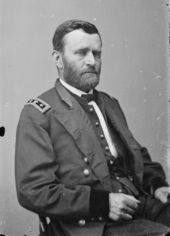 Ultimately, the CSA needs to preserve control of at least one VP city in each state to deny the bonus VPs to the USA player. One way is to build a strongpoint defense at a key city in each state and keep a mobile force in the area threatening to retake any city the USA does not garrison properly. Unfortunately for the CSA, they cannot have a strong defense everywhere and control of the seas allows the USA to open new fronts along rivers and coastlines on a regular basis. Creating and exploiting these opportunities is essential for successful USA play. Learning how to prepare for this and deal with it is essential for successful CSA play.
Ultimately, the CSA needs to preserve control of at least one VP city in each state to deny the bonus VPs to the USA player. One way is to build a strongpoint defense at a key city in each state and keep a mobile force in the area threatening to retake any city the USA does not garrison properly. Unfortunately for the CSA, they cannot have a strong defense everywhere and control of the seas allows the USA to open new fronts along rivers and coastlines on a regular basis. Creating and exploiting these opportunities is essential for successful USA play. Learning how to prepare for this and deal with it is essential for successful CSA play.
Game Resources:
Links and additional pages regarding Victory Games The Civil War
| VITAL CSA STRATEGIES Shannon McNamara – Dec 8, 2009 | Eastern Theatre of Operations | Unofficial 3rd Edition WGA rulebook (3.73MB) | Consimworld forum link |
| Board game geek page | |||


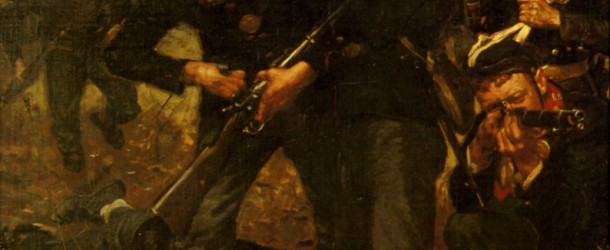
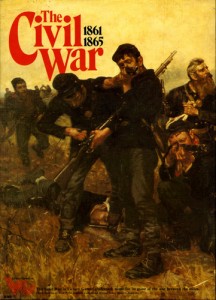
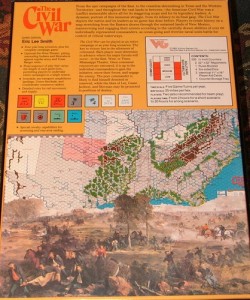






Hi Tom,
I also recently came to the conclusion that I preferred this treatment of the Civil War over For the People. Would you be interested in playing this online using Vassal? If so send me an email and we can maybe get a game started.
Regards,
Steve Rugge
Hi, Steve:
Just in case Tom doesn’t see this message I forwarded it to him.
Thanks,
– Fred
Guys, I know this probably isn’t the place for this, but I love this game. Played it many times in the eighties and nineties. Then life got me away from gaming. I have downloaded Vassal and played some solo, but I am intimidated about playing a live opponent as Vassal confuses me. I am not very tech savvy. I would prefer to play live watching the moves as they occur if possible, as it seems to me with the interactive nature of this and some other games I like, such as Russian Front, how could you not play real-time?. Would any of you be interested in helping a Vassal virgin get back into the wargaming hobby?
Crap. Sorry for the double post. See, I told you I wasn’t tech savvy. Thought the first post didn’t take because I forgot to post it. Figured out it wasn’t displayed because it hadn’t been reviewed by the moderator. I miss the eighties…
Don’t worry. I’m here to fix things. – Fred
I’d suggest finding a local group of gamers or going to a game convention. If you live in the New York area, there is Fatdog in 2 weeks. Otherwise I’d suggest Origins (but wargames are few and far between there), WBC, Tempe (Consimworld Expo) or Prez Con. Long Island has an exceptionally active group of guys, many of which post articles here by the way. And everyone is welcomed to stop by our weekly meeting.
Thanks for the reply. Unfortunately I live in Louisville and the gaming clubs here do not do real wargames. This is why the Vassal idea appeals to me if I can learn how to do it. I appreciate the tip, Fred.
Lee:
I’d suggest either asking on its Consimworld page, which is linked at the bottom of the article, who lives in your area or posting a question on the front page of BoardgamingGeek asking how to find any local wargame club. I’m sure there are guys in your area interested in Victory Games “The Civil War,” they just are keeping a low profile.
Steve and Lee;
I am currently playing a game via VASSAL now, and my game schedule is pretty full. This game is actually quite easy to play using the VASSAL module, and sending LOG files for each move works pretty well for the small group of us that play regularly. Use the link to go to the consimworld folder for this game and you might be able to dragoon one of the other guys into a learning game. They are a very good group to game with.
OK – Thanks Tom. I’ll check out Consimworld.
Hey Steve – I’m open to playing via vassal/pbem –
it’s great with this game.
Thanks
Pete
I liked seeing this, and hope to try it again eventually. Perhaps some day I will “fix” the problems with New Mexico that keep me from bothering with the extended map. These range from the cosmetic (Albuquerque on the wrong side of the Rio Grande) to the blatantly ahistorical (Valverde was the location of a ford on the Rio Grande, and not a particularly important ford at that; there has never been a community there, and it was not a strategic location). Aside from the forces in the area (including the California Column) being too small for the game scale, there is zero reason for the Confederates to venture into Glorieta Pass, where a decisive battle was fought (they were headed to Fort Union — modern Las Vegas, NM — off map to capture the fort and perhaps the territorial government, which had fled Santa Fe).
Incidentally, the Union should get the points for controlling New Mexico in all scenarios except the initial campaign; after Glorieta Pass, the Texans retreated all the way back to El Paso, and then also abandoned that city upon the approach of the California Column.